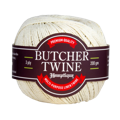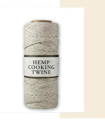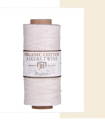Kitchen Twine 101:
What is Kitchen Twine and How to Use It
What Are the Best Cooking Twine Alternatives

Innovation & Quality
Developing and supplying premium-quality, sustainably grown, consumer products
100% Natural
Organically Grown and Ethically Sourced
hemp and other natural fiber products
Shipping
We offer fast shipping
Your order out within 1-3 days
Wholesale
Visit our wholesale portal to register or login to your account
Kitchen twine may be considered essential kitchen equipment. Whether you must truss chicken or turkey, secure stuffed loin, or tie a packet of herbs, it is always good to have kitchen twine on hand.
It is found in special stores which sell kitchen equipment or stores that sell all kinds of twines. It is made to be safe for use and strong enough to truss food. Kitchen twine creates a uniform shape of irregular-shaped meat and helps cook more evenly. This type of twine makes a versatile addition to your kitchen due to its diverse uses.
In this article we will list its uses, how to use it and how to choose the perfect cooking twine material.
It is found in special stores which sell kitchen equipment or stores that sell all kinds of twines. It is made to be safe for use and strong enough to truss food. Kitchen twine creates a uniform shape of irregular-shaped meat and helps cook more evenly. This type of twine makes a versatile addition to your kitchen due to its diverse uses.
In this article we will list its uses, how to use it and how to choose the perfect cooking twine material.
Buy 100% Natural Kitchen Twine at Hemptique
Hemptique offers the finest hemp and organic cotton kitchen twine. We always aim to develop and supply 100% organically grown and ethically sourced products. We tend to raise awareness for earth-friendly products. Hemptique hemp cooking twine and cotton bakers twine are eco-friendly, AZO-Free dye, oil-free and fully biodegradable. You can buy retail or in high volume. If you wish to become a wholesaler, call us at 760-602-4864. ext. 403 and 405. or follow this link and apply for wholesale account.
TYPES OF COOKING TWINE
Twine usually differs depending on material and strength. Due to these characteristics, we purchase twine for specific purposes. Ideal for cooking should be natural, not impact food taste and be able to resist heat. And other, colorful twines can be perfect for decoration and box packing.
Baker’s Twine
Baker’s twine is a great choice for gift-wrapping, scrapbooking, tying off bags of cookies and candy, securing cake boxes or decorating your plating. It is typically made from cotton or polyester/cotton mix. Even though it is food safe it is not intended for cooking. Materials from which baker’s twines are made are durable and can stretch. They usually come in different colors or stripes to add an extra decorative feature to different uses.
Butcher Twine
Bitcher twine is another name for cooking or kitchen twine. It is used to truss meat to cook it evenly inside and outside. Sometimes we use it when rolling up stuffed meat or hanging salami and sausages for curing. Some people tie off a bundle of herbs with butcher twine. Butcher twine is usually made from cotton, and it is always advisable to buy organic one. Cotton is an oven and food-safe material which is strong when making tight knots.
Industrial Twine
This type of twine is not recommended to be used for food since it is made from polypropylene. Nevertheless, industrial twine is durable and waterproof, which makes it perfect for securing items in food trucks or retail shops. It resists rotting and mildew, and you can make bundles of newspapers, bins or cupboards and keep them in storage.

DIFFERENT TWINE MATERIALS
Depending on what you’ll use the twine for, you can choose between natural or synthetic materials. Natural materials include linen, hemp, cotton and jute, while synthetic include polyester and polypropylene.
Make sure to choose wisely if you use twine for food making since synthetic materials are not food-safe and are more suited for decoration.
Make sure to choose wisely if you use twine for food making since synthetic materials are not food-safe and are more suited for decoration.
Hemp Twine
Hemp is 100% non-toxic for food since it is eco-friendly, compostable, and biodegradable. The hemp twine is made by twisting two strands together, which makes the fiber stronger and more durable. It is naturally resistant to UV light, mold, and mildew. It is a long-lasting and low-stretch material perfect for tying herbs, homemade and organic goods from farmers’ market. We can also use it as a baker’s twine for decoration and gift wrapping.
Cotton Twine
Cotton twine is soft and very easy to work with. It does not have chemicals or dyes, which makes it perfectly safe for cooking purposes. It is the most used twine for meat trussing since it is oven-safe, and its strengths help the meat stay evenly tied. Additionally, cotton is a renewable material which makes it one of the most eco-friendly materials. From tying up brisket, pork shoulders to other meats and foods, cotton twine is a must-have item in the kitchen.
Linen Twine
Considered a durable, food-safe, and oven-safe material, linen is excellent for hanging and smoking meat or tying stuffed meat. Linen is made from flax plants and has antibacterial elements since it dries faster than most materials. It can also be used to secure packages in shipping facilities and warehouses.

Jute Twine
Jute twine is not recommended to be used in the oven or with heat. Jute can add antique, retro, natural decoration to your food or napkins. It can be used in the garden to hold plants or pickled vegetables. Jute is a durable, long-lasting, biodegradable, and eco-friendly material, making it entirely non-toxic in the kitchen.
Polyester/Cotton Blended Twine
There are thick and thin blends of poly twine, depending on the purpose of use. Thinner, colored polyester/cotton blend can be used as baker’s twine to decorate packages or table setting. Thicker twine is usually stretchy which adds extra durability and can be used as butcher twine.

SYNTHETIC VS. NATURAL TWINE
Let’s name a few differences between natural and synthetic twine and its pros and cons for kitchen use.
Natural Twine
It is eco-friendly
It is food-safe
- Some are oven-safe too
- Doesn’t affect food flavor
Cons:
Some aren’t heat resistant
- Some may drop fibers
- Some aren’t water and oil-resistant
Synthetic Twine
- Long-lasting and strong
- Cheap
- Water and oil resistant
- Resistant to erosion
Cons:
- Not safe for oven use
- It is not food-safe
- It isn’t environmentally friendly
WHAT TWINE STRENGTH DEPENDS ON
Tensile strength is the amount of pressure twine can withstand before breaking. If you want to identify the strength of your twine, make sure to investigate plies, weight, size, and tensile strength.
- Ply - One single strand is formed by plies and strands braided and twisted together. So, ply refers to the amount of these plies which are twisted together for most kitchen twines. The more plies are there, the stronger the twine will be.
- Weight - The weight of the twine can be light, medium, and heavy.
- Size - You can determine twine’s size by its diameter in millimeters or inches. But sometimes the size is determined by a gauge before which you can see # symbol. The bigger the number, the bigger the diameter of twine. Double check the information in millimeters or inches if the manufacturer used gauge.
WAYS TO USE KITCHEN TWINE TO TRUSS MEAT
As we already said before, butcher twine is used for meat trussing. There are various methods used to prepare meat perfectly with kitchen twine.
The easiest method is to cut a few lengths of twine of the spool and twist each around the meat. Make sure to leave some 3 cm spacing between them. Each loop may be tied with a simple knot, such as the one when we tie our shoelaces. An extra twine can be trimmed off.
Butcher’s knot is a popular way among professional chefs. Twine is again pulled off the spool and tied over one end of the piece of meat. The loop is formed at the top and overlaps the first part of the twine, then the second loop a short distance away. The process goes on in the same way until the whole piece is trussed.
The last method is considered a complicated one. The chef would use special needles to pin both sides of meat to put it back together. Each needle has open loops on one side and cook can thread twine between these loops. In the end all needles should be threaded and tightened strongly to keep meat firmly in place.
The easiest method is to cut a few lengths of twine of the spool and twist each around the meat. Make sure to leave some 3 cm spacing between them. Each loop may be tied with a simple knot, such as the one when we tie our shoelaces. An extra twine can be trimmed off.
Butcher’s knot is a popular way among professional chefs. Twine is again pulled off the spool and tied over one end of the piece of meat. The loop is formed at the top and overlaps the first part of the twine, then the second loop a short distance away. The process goes on in the same way until the whole piece is trussed.
The last method is considered a complicated one. The chef would use special needles to pin both sides of meat to put it back together. Each needle has open loops on one side and cook can thread twine between these loops. In the end all needles should be threaded and tightened strongly to keep meat firmly in place.
WHAT CAN I USE INSTEAD OF KITCHEN TWINE?
Aluminum foil
It is not strong enough to hold whole chicken or turkey, but it can work for stuffed meat. We can roll up some aluminum foil and make ropes like bands to secure food.
Dental floss
Make sure to buy unwaxed, plain dental floss, so your food doesn’t have a mint taste. Waxed floss can be dangerous for the oven since the wax could ignite while baking. Floss will hold food as tight as cooking twine.
Toothpicks or wooden skewers
Toothpicks and wooden skewers should be soaked in water before use since they can catch fire in the oven. We can poke them into our rolled and stuffed meat and prevent unraveling. Remember to count the toothpicks that you put in your meat so that no one bites into the pick while eating.
Go without it
We can leave turkey or chicken untrussed by just tucking the wingtips under the bird or cover the whole bird with aluminum foil to prevent burning. Loins can be placed on the baking sheets side down to hold them together. And if we want to secure herbs, we can use corners of cheesecloth.











